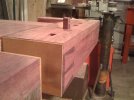- Joined
- Aug 26, 2011
- Messages
- 250
I was wondering about remove the burr at low grit 120~240 grit. The particle arrangement on stones are random, so, the scratches may not match every stroke. Even in light pressure you may not remove it at all.
If you think in medium grit like 400~800 under a magnifier vision, it may happen but my guess is on medium grit leather strop (with compound) may clean the bottom of valley scratches and at medium grit the burr itself is more thin and soft.
If you are going to stabilize an edge (or just finishing it) at low grit, remove the burr and clean it before go to next stone (or not if is the case), how did you do it?
If you think in medium grit like 400~800 under a magnifier vision, it may happen but my guess is on medium grit leather strop (with compound) may clean the bottom of valley scratches and at medium grit the burr itself is more thin and soft.
If you are going to stabilize an edge (or just finishing it) at low grit, remove the burr and clean it before go to next stone (or not if is the case), how did you do it?



